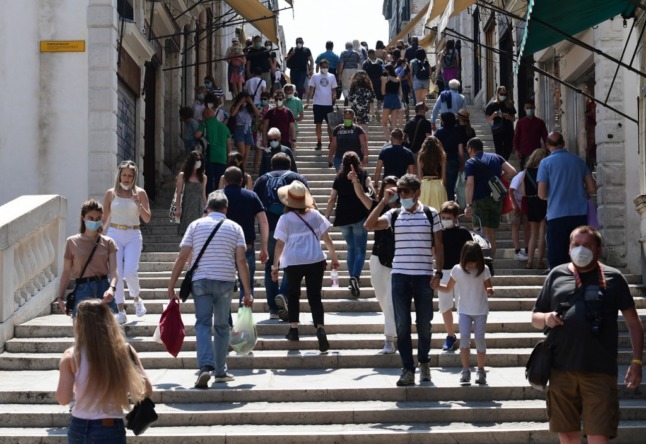There has been widespread concern about just how quickly health restrictions – potentially including restrictions on businesses and the banning of large events – could make a comeback in Italy after several regions recently recorded sharp increases in the infection rate.
Since the end of June, every region of Italy has been in the low-risk ‘white’ zone – the least restrictive of the country’s four tiers or zones: white, yellow, orange and red.
READ ALSO: What are the rules on travel to Italy right now?
But the steep trajectory of the recent rise in cases in several areas means that, under current rules, some regions risk having ‘yellow’ or potentially even ‘orange’ zone rules reimposed within weeks.
The regions of Sardinia, Sicily, Veneto. Campania and Lazio are thought to be at the highest risk of turning ‘yellow’ in the coming weeks, based on the most recent weekly health data report published by the Higher Health Institute (ISS) and Italian health ministry on Friday.
Currently, regions automatically move from the white to the slightly more restrictive yellow zone if they record more than 50 infections per 100 thousand inhabitants in a seven-day period for three weeks in a row.

Overall Italy’s average nationwide incidence rate is now 19 cases per 100,000 inhabitants, ISS data shows, with significant variation between regions.
Sardinia and Sicily have the highest incidence rates in the country at 33.2 and 31.8 respectively. They are followed by Veneto (26.7), Lazio (24) and Campania (21.7).
Despite the rise in cases however ISS head Silvio Brusaferro said on Friday that, for now, “the impact on hospital admissions remains minimal”.
Regional leaders have asked the health ministry to act amid concerns about the economic impact if restrictions made a comeback by August – Italy’s busiest month both for international tourist arrivals as well as for domestic holiday bookings.
Hospitalisation and intensive care occupancy rates will now become more important factors in deciding whether to impose new restrictions, Health Minister Roberto Speranza has confirmed.
“The number of infected people is rising, especially among children, but in most cases there is no need for hospitalisation and for this reason we have chosen to leave businesses open, favouring those who decide to inoculate themselves in order to prevent the circulation of the virus,” Speranza told reporters on Sunday.
Speranza was referring to the government’s plan to expand the use of its ‘green pass’ health certificate, requiring people to show proof of full vaccination, testing or recovery in order to enter more venues and potentially even to visit restaurants and gyms.
READ ALSO: What is Italy’s digital ‘green pass’ used for and how do you get it?
Italy’s green pass has been in use since June 17th, but at present it is only needed in order to access care homes or large events like concerts, sports matches and wedding receptions.
The government is hoping that the altered parameters and the extended green pass system will be enough to keep restrictions low and businesses open until at least the Ferragosto holiday in mid-August, according to Italian media reports.
European countries including Italy which are now seeing a rise in cases driven by the Delta variant are looking to the UK, where hospitalisation rates are now rising, to understand how long it could take before they too see an increase in the number of Covid-19 patients being admitted and how big that increase could be.
The Italian health ministry previously adjusted the zone criteria in May to focus more on hospitalisations and intensive care bed occupancy, aiming that time to allow more regions to relax measures in time for summer.
Government ministers are expected to finalise a new decree setting out the details of its changes on Tuesday following debates on Monday, newspaper Corriere della Sera reports.
An official announcement is expected by the middle of this week.
For further details on the current coronavirus situation in Italy, see the Health Ministry’s website (in English).



 Please whitelist us to continue reading.
Please whitelist us to continue reading.
Member comments